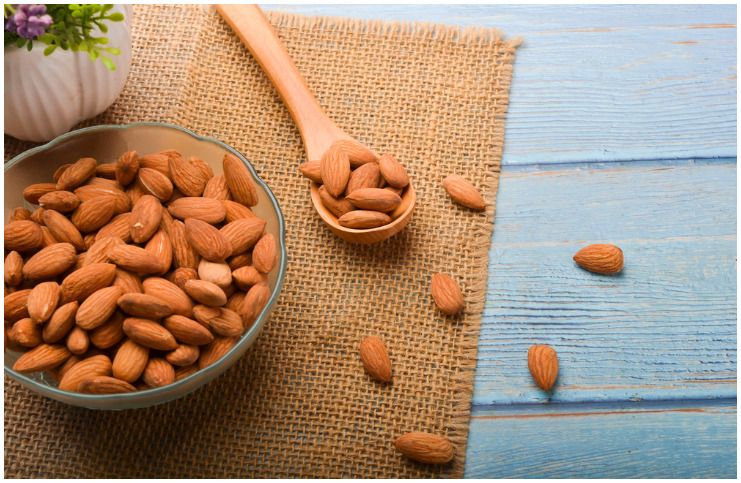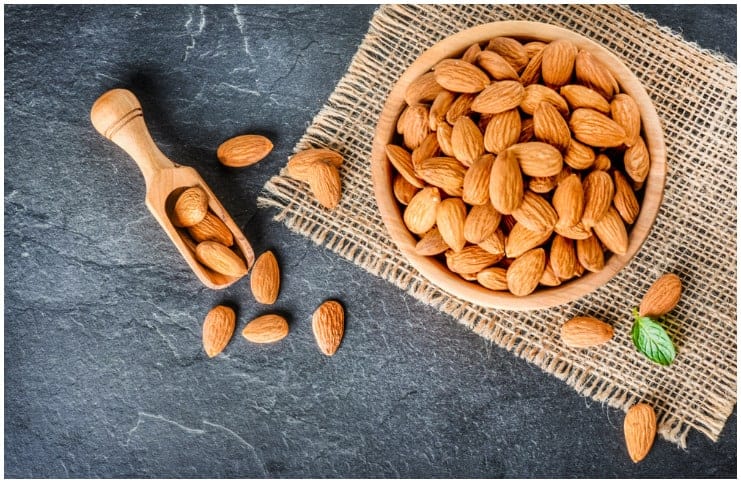Peanuts
They are popularly known as monkey nuts, groundnuts, pig nuts, however, peanuts actually belong to the legume family and are therefore related to lentils, beans, chickpeas, and soy.
Nevertheless, this small seed has numerous nutrients packed in it and you will be amazed by its health benefits, so, let’s look in detail.
Fiber
A 1 oz. serving of groundnuts contains 2.5 g of dietary fiber, meeting 10% of your daily recommended intake. Diets high in dietary fiber have been strongly associated with a reduced risk of heart disease and some types of cancers, and also have been shown to help with weight management.
Protein
They are an excellent source of dietary protein which is crucial for growth and development.
Furthermore, consuming groundnuts regularly helps fight depression due to their high content of tryptophan, an essential amino acid that is vital for the production of serotonin, a chemical messenger that is passed between nerve cells and is involved in mood regulation.
Fat
Occasionally, groundnuts get a bad rap due to their high-fat content (49,7g/100g). Nevertheless, they contain polyunsaturated and monounsaturated fats that are required for the smooth functioning of the body. In addition, a good level of both (polyunsaturated and monounsaturated fats) results in lowering LDL and total cholesterol levels, hence, lowering the risk of coronary heart diseases.
According to the Institute of Medicine, you should get at least 12 grams of healthy fatty acids per day.
Vitamins
They are a good source of thiamin, pantothenic acid, riboflavin, vitamin B6, E, and choline.
They also have one of the highest content of vitamin B3. According to research, people getting the most vitamin B3 from foods were 70% less likely to develop neurodegenerative conditions, especially Alzheimer’s disease. Another important aspect of this vitamin is that it enhances out immunity which helps keep flu, colds, and common infections at bay.
The folate present in groundnuts reduces the risk of having a baby with serious neural tube defects (birth defects of the spine, brain, or spinal cord). However, it is recommended to start eating foods high in folate (for lowering the risk of neural tube defects) before planning to get pregnant and during pregnancy.
Minerals
Calcium, selenium, magnesium, iron, zinc, and phosphorus are some of the minerals present in groundnuts. These essential minerals have an important role in numerous different body functions.
In addition, peanuts are a good source of potassium, an essential mineral that counters the side effects of too much sodium in the diet. Moreover, they contain manganese, a trace mineral which regulates glycemic levels and offers protection from bad cholesterol.
Lastly, they are a remarkable source of copper, a nutrient which has been shown to lower LDL cholesterol as well as it raises HDL cholesterol levels.
Other Nutrients
They are rich in antioxidants, like – p-coumaric acid and resveratrol. The former is known to lower the risk of stomach cancer while the latter is beneficial against viral infections, heart problems, degenerative diseases, and cancers.
Additionally, they are packed with phytosterols. According to a 2012 study, the consumption of foods rich in phytosterols protects against heart diseases and helps in the promotion of healthy cholesterol levels.
Tips
Unsalted dry roasted groundnuts are a healthier option than salted ones, as most people consume too much sodium.
You can store them in a cool, dry place, like a refrigerator. Keep unshelled nuts for up to 12 months in an airtight container in the fridge and shelled nuts for 5 months.
Almonds

They have been prized since ancient times as one of humankind’s most beloved nuts. For example, they received about ten mentions in the Bible, the 1st of which in the Genesis, that describes them as being “among the best of fruits.”
Nowadays, California is the largest producer of almonds in the world. Interestingly, the production has raised more than 100 percent in the past 20 years. The main cause of this is, most likely, that more and more people are becoming aware of the health benefits of these nuts.
Fiber
They have 12,2g of fiber per 100g, which is 49 percent of the daily recommended intake. Many studies have concluded that consuming foods with fiber content regularly can help people manage their LDL cholesterol and increase satiety levels.
Protein
A quarter cup of almonds provides you with 5 grams of protein, that is approximately 10% of the daily recommended intake. Protein can help a person maintain energy and strength and is the building block for muscles. In addition, vital tissues, organs, and even some hormones of the body are made from proteins.
The Institute of Medicine recommends women consume 46 grams, men at least 56 grams, and nursing and pregnant women intake at least 71 grams of protein daily.
Fat
Around 90 percent of almond fat consists of poly- and monounsaturated fatty acids, that have been associated with a lower risk of cardiovascular disease. In addition, it is interesting to note that about 15 percent of the total almond’s calories are not absorbed by the human body, due to the fact that the fat is too hard to digest.
Vitamins
They are a rich source of numerous essential B-complex groups of vitamins, like – niacin, riboflavin, thiamin, vitamin B6, and pantothenic acid. B-complex vitamins work as co-factors for enzymes during cellular substrate metabolism inside the body.
Furthermore, they contain vitamin E which works as a powerful antioxidant that inhibits free radical damage. In addition, vitamin E is believed to be a skin food, keeping it glowing and smooth.
They are also a good source of folate, which plays an important role in healthy tissue configuration and cell growth, hence, it is essential for the healthy growth of the fetus.
Minerals
Almonds contain iron, calcium, manganese, zinc, phosphorus, copper, and selenium.
More importantly, they also contain magnesium (with 30g providing 20% of the recommended daily intake), an essential mineral that has numerous health benefits, including the regulation of blood sugar and insulin.
Additionally, one serving of almonds represents 5% of the recommended daily value of potassium, a mineral that is needed for heart health, among other benefits.
Other Nutrients
They contain flavonoids, especially in the skins, which work in synergy with vitamin E, therefore, lowering the risk of heart disease.
Tips
You can soak them in water overnight so you can eat them in the morning. Soaking will enhance their nutritional profile. Furthermore, crushed almonds are a delicious garnish for a number of dishes.
As almonds age, they go rancid. A fresh almond will look white in the middle after slicing through it. They are best stored in an airtight container in the freezer.
Conclusion: Peanuts vs Almonds – Which Is Healthier?
In our opinion, almonds (which contain 49%DV fiber) are slightly better for weight loss than peanuts (32%DV fiber) as well as for overall health, due to a higher amount of vitamins, minerals, and essential fatty acids.
Almonds (100g) Peanuts (100g)
Vitamin E 131% 35%
Vitamin B2 60% 6%
Vitamin B3 17% 68%
Folate 12% 36%
Calcium 26% 5%
Magnesium 68% 44%
Phosphorus 48% 36%
Copper 50% 34%
Omega 3 6mg 3mg
In regard to the rest of the nutrients, they are almost similar.
References https://www.ncbi.nlm.nih.gov/pmc/articles/PMC3257681/ http://news.psu.edu/story/458500/2017/03/29/research/
